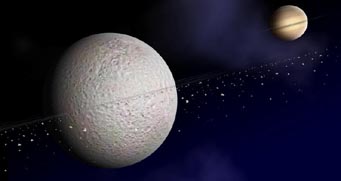A fascinating article in the March 7th issue of Science magazine describes how, when NASA's Cassini spacecraft skimmed within 300 miles of the Saturnian moon Rhea in November 2005, several instruments detected what appear to be a tenuous dust disk around it containing three thin, sparse rings.

An artist's concept shows the ring of debris (exaggerated for clarity) that may orbit Saturn's second-largest moon, Rhea.
NASA / JPL / JHU-APL
I say "detected" the disk and rings because Cassini's cameras didn't see them. Instead, the encircling matter selectively absorbed electrons whizzing in Saturn's magnetosphere, causing "particle shadows" that the instruments recorded.
NASA and the European Space Agency jointly issued a press release about the Cassini result, but it doesn't nearly tell the whole story.
Instrument readings suggest that a thin disk of dust extends out to 4,000 miles (6,000 km), within which Rhea's gravity dominates that of Saturn. There'd been hints that something odd was happening near Rhea back in 1980, when Voyager 1 went by.
The 35-member team for the Science write-up argues that there's far too much dust to have simply been blasted from Rhea's surface by meteoritic impacts (some of which they expected). Nor can it be due to an extended gas atmosphere — none was detected. And nothing like this was seen during similarly close flybys of neighboring Tethys and Dione.
One instrument recorded a trio of brief, sharp dips in magnetospheric electrons as the spacecraft approached Rhea and again as it sped away. These dropouts imply that Rhea has thin rings located roughly 1,000, 1,200, and 1,260 miles from its center (Rhea itself has a radius of 475 miles or 765 km.)
The team believes these rings could have existed stably around Rhea for many millions of years — long enough to have been created by a major impact with its icy surface some tens of millions of years ago or conceivably enduring since Rhea itself formed.
(For the record, this isn't the first time that charged-particle measurements have betrayed the presence of rings. Similar phenomena, recorded by Pioneer 11 as it swept close by Saturn in 1979, led to the discovery of the planet's F and G rings.)
But what I find most fascinating about this paper is that these ring particles are likely big — their mean diameter could be basketball size or larger — and the team estimates that the total mass involved is of order 10 million tons. Had Cassini passed through Rhea's equatorial plane (where the disk and rings most likely lie) rather than skirting just 125 miles south of it, this particular flyby might have had a much different, potentially catastrophic outcome.
After all, notes lead author Geraint Jones, "No one was expecting rings around a moon."
 3
3
Comments
Al Wilson
March 7, 2008 at 2:36 pm
If I understand the paper correctly, it suggests the density of the "ring" is 1 particle per 10 square km volume in the densest part! Don't think Cassini need fear Rhea. :o)
You must be logged in to post a comment.
Marc
March 9, 2008 at 3:52 pm
Well written man... only your timeline isn't mine. Why involve those 'millions of years' in the story?
I'm glad you say the team believed the rings 'COULD HAVE existed stably around Rhea for many millions of years'. Thus not presenting the millions of years theory (because a theory it is) like a fact.
Why am I saying this? I think if you look at these strange rings as 'created' instead of 'formed in x million years', some really interesting things will come out of it.
For the rest, I like your articles. Really good!
Marc
You must be logged in to post a comment.
Grant Martin
March 16, 2008 at 11:31 am
Uh, Marc, if you don't buy the notion that the universe is at least millions (let alone billions) of years old, how do you explain the FACT that it takes light, travelling 186,000 miles per second, about 2 million years to reach us from the Andromeda galaxy? Are you saying that the photons must have been created in mid-space, 6,000 light-years away from the earth? Of course, this would also mean that the photons that appear to be coming to us from all the rest of the universe must have been created in a vast, 6,000 light-year radius sphere at the same time, all of them travelling at the speed of light toward the center of the sphere. Can you cite a physical process that would cause this?
You must be logged in to post a comment.
You must be logged in to post a comment.